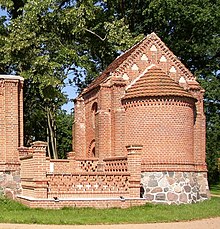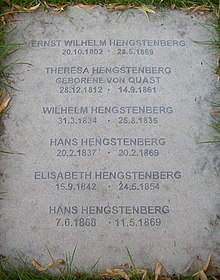Ernst Wilhelm Hengstenberg
Ernst Wilhelm Theodor Hengstenberg (born October 20, 1802 in Fröndenberg (Grafschaft Mark), † May 28, 1869 in Berlin ) was a German Protestant theologian and Old Testament scholar.
Life
Ernst Wilhelm Hengstenberg was the son of the Reformed pastor Johann Heinrich Karl Hengstenberg and his wife Wilhelmine then Bergh. The superintendent Karl Hengstenberg and the consistorial councilor Eduard Hengstenberg were his brothers.
In 1808, Hengstenberg and his family moved to Wetter an der Ruhr. There he received his first lessons from his father. After attending school, Hengstenberg began to study philosophy , oriental studies and increasingly theology in Bonn in 1819 at the age of 17 . He finished his studies in 1823 with a doctorate to become Dr. phil. During his studies in 1820 he became a member of the Germania Bonn fraternity . After a short stay with Johann Jakob Stähelin (1797–1875) in Basel , Hengstenberg completed his habilitation in Berlin in 1824 and received another doctorate in 1825 (Lic. Theol.).
Hengstenberg was appointed to Berlin in 1826 as an extraordinary professor of the Old Testament , and two years later he was promoted to full professor at the same chair.
Hengstenberg, who was friends with August Hahn and was also in close contact with August Tholuck and August Neander , was initially a proponent of the idea of union ( Church of the Old Prussian Union ), but then opposed it decisively. He was a representative of the repristination that the revival movement was close to, and founded in 1827 against the rationalism positioned Protestant church newspaper .
This newspaper also resulted in close collaboration with Friedrich Julius Stahl , Heinrich Leo and the brothers Ernst Ludwig and Otto von Gerlach .
In 1829 Hengstenberg married Therese von Quast (1812–1861) in Radensleben (near Neuruppin ). With her he had several children, including the pastor Immanuel Hengstenberg (1830–1863), the court assessor Johannes Hengstenberg (1837–1869) and the Nassau Chief President Wilhelm Hengstenberg .
Heinrich Heine mentioned Ernst Wilhelm Hengstenberg in his verse epic Atta Troll as well as in Germany. A winter fairy tale , here alluding to Hengstenberg's attack on Goethe .
Estate library
Hengtenberg's extensive estate library (over 20,000 titles in 12,500 volumes) was purchased in 1869 by the Baptist Union Theological Seminary , which was incorporated into the University of Chicago's Divinity School in 1892 . Today it is part of the university library.
Fonts (selection)
- Aristotle : metaphysics . Bonn 1824 (translation with commentary)
- Christology of the Old Testament and Commentary on the Messianic Prophecies of the Prophets (1.1829–3.1835)
- Contributions to the introduction to the Old Testament (1.1831–3.1839)
- The Authenticity of Daniel (1831)
- Commentary on the Psalms (1.1842–4.1845)
- The Gospel of St. John (1.1861-3.1863)
- The Prophecies of the Prophet Ezekiel Explained for Those Who Search the Scriptures (1.1867–2.1868)
- History of the Kingdom of God under the Old Covenant (1.1869–3.1871)
- Lectures on the history of suffering (1875)
literature
- Johannes Bachmann : Ernst Wilhelm Hengstenberg. Three volumes. Bertelsmann, Gütersloh 1876/1880/1892 Volume 1 , Volume 2 , Volume 3
- Otto von Ranke: Hengstenberg, Ernst Wilhelm . In: Allgemeine Deutsche Biographie (ADB). Volume 11, Duncker & Humblot, Leipzig 1880, pp. 737-747.
- Karl Kupisch : Hengstenberg, Wilhelm. In: New German Biography (NDB). Volume 8, Duncker & Humblot, Berlin 1969, ISBN 3-428-00189-3 , p. 522 f. ( Digitized version ).
- Hans Wulfmeyer: Ernst Wilhelm Hengstenberg as a denominationalist . Erlangen 1970.
- Joachim Mehlhausen : Hengstenberg, Ernst Wilhelm. In : Theologische Realenzyklopädie , Volume 15, 1986, pp. 39-42.
- Friedrich Wilhelm Bautz : Hengstenberg, Ernst Wilhelm. In: Biographisch-Bibliographisches Kirchenlexikon (BBKL). Volume 2, Bautz, Hamm 1990, ISBN 3-88309-032-8 , Sp. 713-714.
- Helge Dvorak: Biographical Lexicon of the German Burschenschaft. Volume I: Politicians. Sub-Volume 2: F-H. Winter, Heidelberg 1999, ISBN 3-8253-0809-X , p. 297.
- Matthias A. Deuschle: Ernst Wilhelm Hengstenberg. A contribution to the study of church conservatism in Prussia in the 19th century (= contributions to historical theology, volume 169), Tübingen 2013, zugl .: Habil.-Schr., Humboldt-Univ. Berlin 2010.
Web links
- Literature by and about Ernst Wilhelm Hengstenberg in the catalog of the German National Library
- Works by and about Ernst Wilhelm Hengstenberg in the German Digital Library
- over 30 digitized works at archive.org
Individual evidence
- ^ Peter Siemens: Hengstenberg, Ernst Wilhelm. (1802-1869) . In: Helmut Burkhardt, Uwe Swarat (ed.): Evangelical Lexicon for Theology and Congregation . tape 2 . R. Brockhaus Verlag, Wuppertal 1993, ISBN 3-417-24642-3 , p. 893 .
- ↑ Full text of Caput XVIII of the poem Atta Troll. A midsummer night's dream
- ↑ Full text of Caput XI of the poem Germany. A winterstory
- ↑ Jan Rohls : "Goethedienst is worship". Theological remarks on the veneration of Goethe. In: Jochen Golz and Justus H. Ulbricht (eds.): Goethe in society . Cologne / Weimar / Vienna 2005, p. 34
- ^ Ernst Wilhelm Hengstenberg Collection , accessed on January 31, 2020
| personal data | |
|---|---|
| SURNAME | Hengstenberg, Ernst Wilhelm |
| ALTERNATIVE NAMES | Hengstenberg, Ernst Wilhelm Theodor |
| BRIEF DESCRIPTION | German avangelical theologian and Old Testament scholar |
| DATE OF BIRTH | October 20, 1802 |
| PLACE OF BIRTH | Fröndenberg (County of Mark) |
| DATE OF DEATH | May 28, 1869 |
| Place of death | Berlin |


